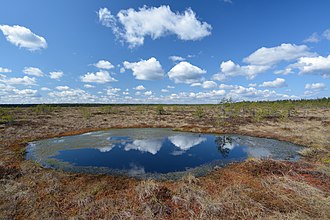Bog



File:Drone video of Kakerdaja bog in Estonia (september 2021).webm

Bog is a type of wetland that accumulates peat, a deposit of dead plant material—often mosses, and in a majority of cases, sphagnum moss. It is one of the four main types of wetlands. Other names for bogs include mire, quagmire, and muskeg; alkaline mires are called fens. They are frequently covered in heath or heather in the upper regions of the Northern Hemisphere.
Characteristics[edit]
Bogs are characterized by their poor soil nutrients, high acidity, and low oxygen levels in the water and soil, which slow down the decomposition process. This results in the accumulation of peat. Bogs are typically found in cool, northern climates. They often develop in basins from lake drainage, on flat ground where they can expand large areas, or as pocosins, which are upland bogs. The water in bogs is usually rainwater rather than groundwater and is very low in nutrients.
Formation[edit]
Bogs form when the water at the ground surface is acidic and low in nutrients. Over time, plant material accumulates, and peat is formed due to the slow decomposition rate. This process can take thousands of years. The development of a bog can also begin with a lake or pond that gradually fills with plant debris, or from a fen that becomes acidified.
Types of Bogs[edit]
There are several types of bogs, including raised bogs, blanket bogs, and valley bogs. Raised bogs, found in cool, temperate climates, are the most common type. They are characterized by a dome-shaped area that rises above the landscape due to the accumulation of peat. Blanket bogs cover large areas of flat land and are often found in maritime climates with high rainfall. Valley bogs are found in glacial valleys and are usually smaller than other types of bogs.
Ecology[edit]
Bogs play a crucial role in the ecosystem by storing carbon, thus reducing greenhouse gases in the atmosphere. They also provide unique habitats for a variety of plants and animals. Some species, such as the sundew and the Venus flytrap, have adapted to the nutrient-poor conditions by becoming carnivorous, feeding on insects to supplement their nutrient intake.
Conservation[edit]
Bogs are threatened by drainage, peat extraction, and climate change, which can dry them out and release the stored carbon into the atmosphere. Conservation efforts include the restoration of degraded bogs and the protection of existing ones. Restoring a bog can involve blocking drainage channels to raise the water level and allow the natural vegetation to recover.
Cultural Significance[edit]
Bogs have been important in various cultures for thousands of years, providing resources such as peat for fuel, and in some cases, preserved archaeological artifacts and human remains, such as bog bodies, which have been naturally mummified in the acidic, low-oxygen environment.
Ad. Transform your life with W8MD's Budget GLP-1 injections from $75


W8MD offers a medical weight loss program to lose weight in Philadelphia. Our physician-supervised medical weight loss provides:
- Weight loss injections in NYC (generic and brand names):
- Zepbound / Mounjaro, Wegovy / Ozempic, Saxenda
- Most insurances accepted or discounted self-pay rates. We will obtain insurance prior authorizations if needed.
- Generic GLP1 weight loss injections from $75 for the starting dose.
- Also offer prescription weight loss medications including Phentermine, Qsymia, Diethylpropion, Contrave etc.
NYC weight loss doctor appointmentsNYC weight loss doctor appointments
Start your NYC weight loss journey today at our NYC medical weight loss and Philadelphia medical weight loss clinics.
- Call 718-946-5500 to lose weight in NYC or for medical weight loss in Philadelphia 215-676-2334.
- Tags:NYC medical weight loss, Philadelphia lose weight Zepbound NYC, Budget GLP1 weight loss injections, Wegovy Philadelphia, Wegovy NYC, Philadelphia medical weight loss, Brookly weight loss and Wegovy NYC
|
WikiMD's Wellness Encyclopedia |
| Let Food Be Thy Medicine Medicine Thy Food - Hippocrates |
Medical Disclaimer: WikiMD is not a substitute for professional medical advice. The information on WikiMD is provided as an information resource only, may be incorrect, outdated or misleading, and is not to be used or relied on for any diagnostic or treatment purposes. Please consult your health care provider before making any healthcare decisions or for guidance about a specific medical condition. WikiMD expressly disclaims responsibility, and shall have no liability, for any damages, loss, injury, or liability whatsoever suffered as a result of your reliance on the information contained in this site. By visiting this site you agree to the foregoing terms and conditions, which may from time to time be changed or supplemented by WikiMD. If you do not agree to the foregoing terms and conditions, you should not enter or use this site. See full disclaimer.
Credits:Most images are courtesy of Wikimedia commons, and templates, categories Wikipedia, licensed under CC BY SA or similar.
Translate this page: - East Asian
中文,
日本,
한국어,
South Asian
हिन्दी,
தமிழ்,
తెలుగు,
Urdu,
ಕನ್ನಡ,
Southeast Asian
Indonesian,
Vietnamese,
Thai,
မြန်မာဘာသာ,
বাংলা
European
español,
Deutsch,
français,
Greek,
português do Brasil,
polski,
română,
русский,
Nederlands,
norsk,
svenska,
suomi,
Italian
Middle Eastern & African
عربى,
Turkish,
Persian,
Hebrew,
Afrikaans,
isiZulu,
Kiswahili,
Other
Bulgarian,
Hungarian,
Czech,
Swedish,
മലയാളം,
मराठी,
ਪੰਜਾਬੀ,
ગુજરાતી,
Portuguese,
Ukrainian
